Evidence based practice in mental health intervention or treatment for mental disorder
VerifiedAdded on 2022/08/17
|11
|3307
|467
AI Summary
This has been favoured as it develop capabilities of patient to identify and take responsibility for their own recovery (Vita & Barlati, 2019).This essay will further explore the concept of recovery focused care in the mental health management context by reviewing the case study of Katie Andrews, a 25 year old lady who has been given a provisional diagnosis of Major Depressive Disorder (MDD) with psychotic features. The main difference of this disorder with conventional MDD is that apart from symptom of major depression (like
Contribute Materials
Your contribution can guide someone’s learning journey. Share your
documents today.
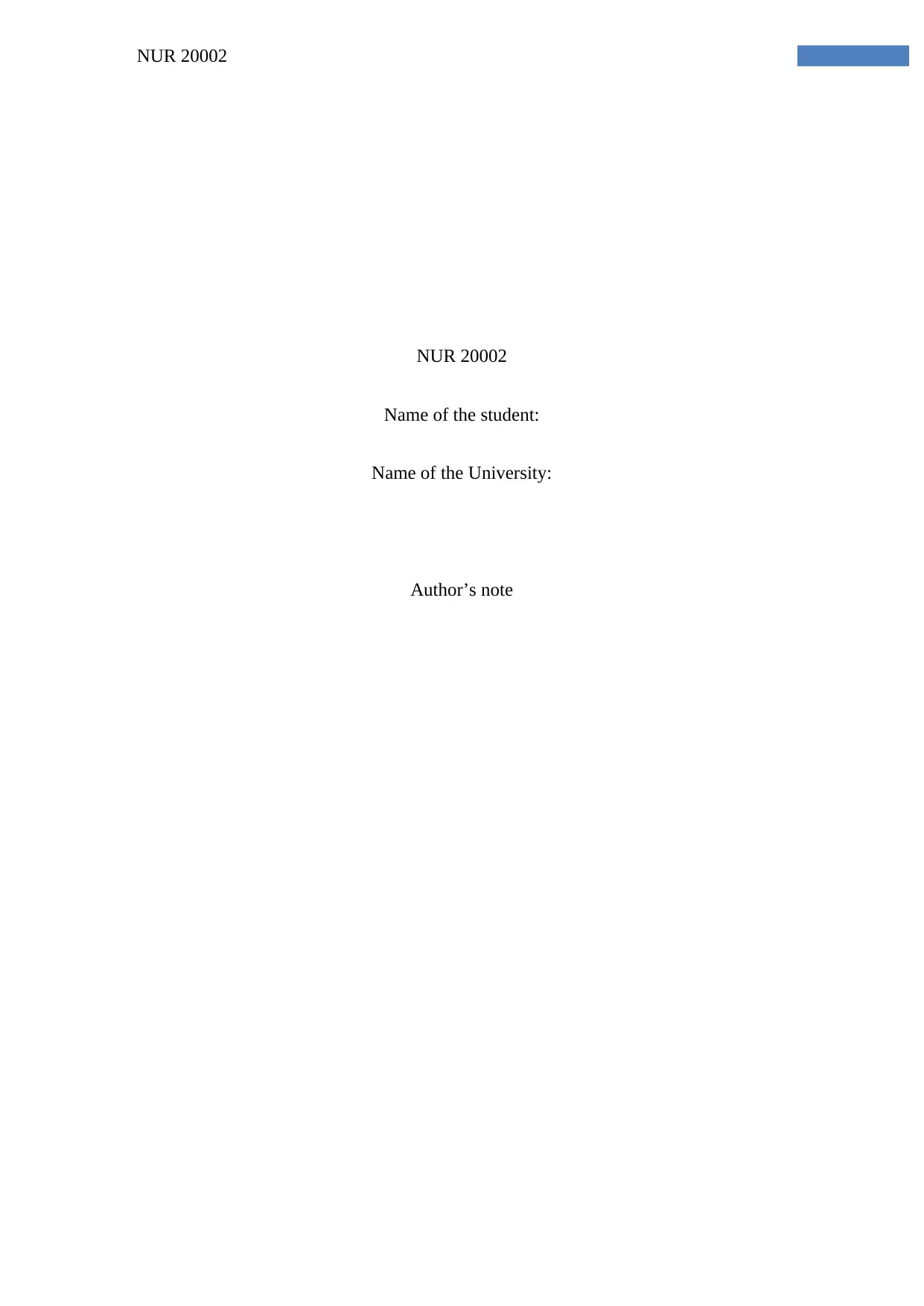
NUR 20002
NUR 20002
Name of the student:
Name of the University:
Author’s note
NUR 20002
Name of the student:
Name of the University:
Author’s note
Secure Best Marks with AI Grader
Need help grading? Try our AI Grader for instant feedback on your assignments.
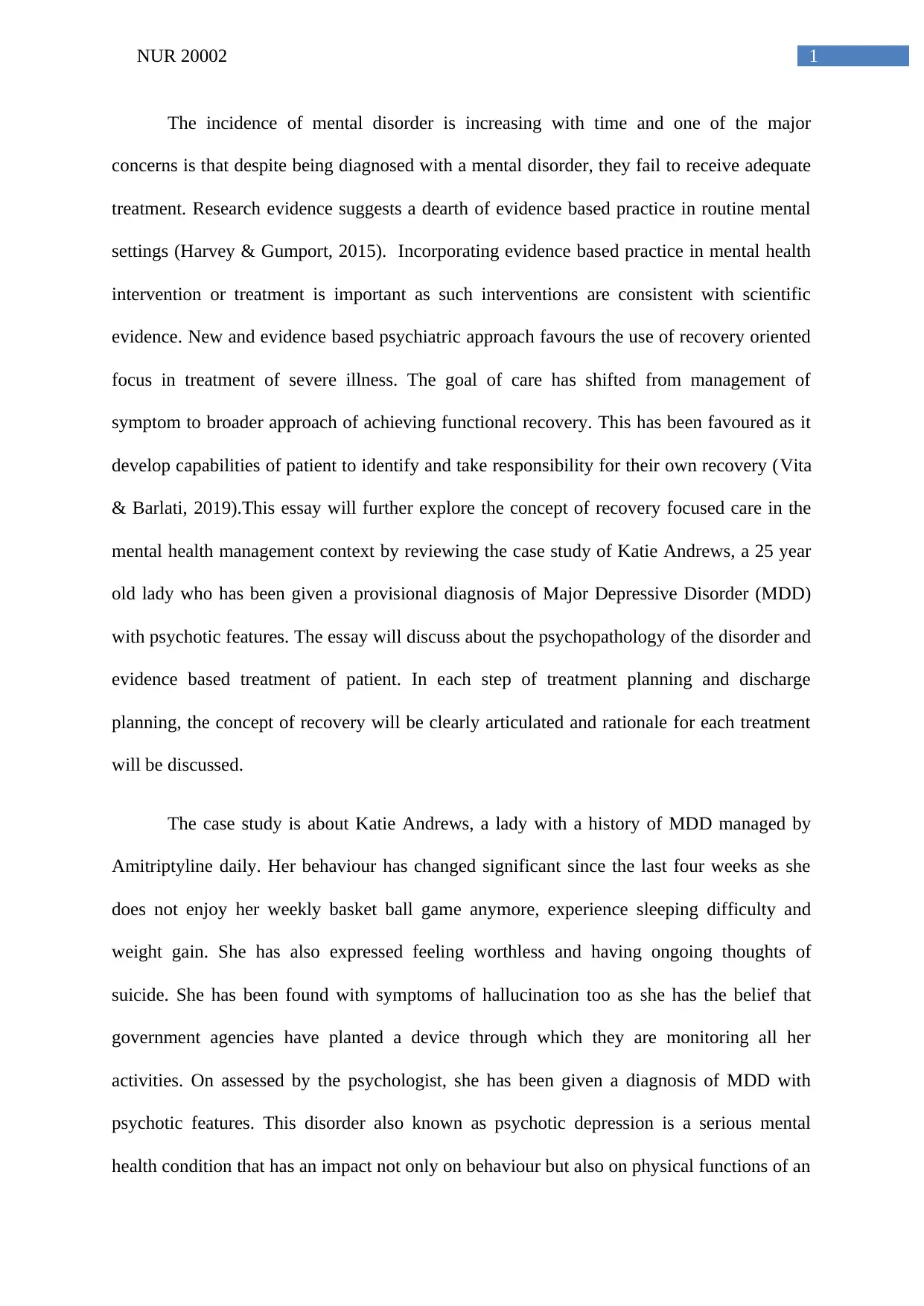
1NUR 20002
The incidence of mental disorder is increasing with time and one of the major
concerns is that despite being diagnosed with a mental disorder, they fail to receive adequate
treatment. Research evidence suggests a dearth of evidence based practice in routine mental
settings (Harvey & Gumport, 2015). Incorporating evidence based practice in mental health
intervention or treatment is important as such interventions are consistent with scientific
evidence. New and evidence based psychiatric approach favours the use of recovery oriented
focus in treatment of severe illness. The goal of care has shifted from management of
symptom to broader approach of achieving functional recovery. This has been favoured as it
develop capabilities of patient to identify and take responsibility for their own recovery (Vita
& Barlati, 2019).This essay will further explore the concept of recovery focused care in the
mental health management context by reviewing the case study of Katie Andrews, a 25 year
old lady who has been given a provisional diagnosis of Major Depressive Disorder (MDD)
with psychotic features. The essay will discuss about the psychopathology of the disorder and
evidence based treatment of patient. In each step of treatment planning and discharge
planning, the concept of recovery will be clearly articulated and rationale for each treatment
will be discussed.
The case study is about Katie Andrews, a lady with a history of MDD managed by
Amitriptyline daily. Her behaviour has changed significant since the last four weeks as she
does not enjoy her weekly basket ball game anymore, experience sleeping difficulty and
weight gain. She has also expressed feeling worthless and having ongoing thoughts of
suicide. She has been found with symptoms of hallucination too as she has the belief that
government agencies have planted a device through which they are monitoring all her
activities. On assessed by the psychologist, she has been given a diagnosis of MDD with
psychotic features. This disorder also known as psychotic depression is a serious mental
health condition that has an impact not only on behaviour but also on physical functions of an
The incidence of mental disorder is increasing with time and one of the major
concerns is that despite being diagnosed with a mental disorder, they fail to receive adequate
treatment. Research evidence suggests a dearth of evidence based practice in routine mental
settings (Harvey & Gumport, 2015). Incorporating evidence based practice in mental health
intervention or treatment is important as such interventions are consistent with scientific
evidence. New and evidence based psychiatric approach favours the use of recovery oriented
focus in treatment of severe illness. The goal of care has shifted from management of
symptom to broader approach of achieving functional recovery. This has been favoured as it
develop capabilities of patient to identify and take responsibility for their own recovery (Vita
& Barlati, 2019).This essay will further explore the concept of recovery focused care in the
mental health management context by reviewing the case study of Katie Andrews, a 25 year
old lady who has been given a provisional diagnosis of Major Depressive Disorder (MDD)
with psychotic features. The essay will discuss about the psychopathology of the disorder and
evidence based treatment of patient. In each step of treatment planning and discharge
planning, the concept of recovery will be clearly articulated and rationale for each treatment
will be discussed.
The case study is about Katie Andrews, a lady with a history of MDD managed by
Amitriptyline daily. Her behaviour has changed significant since the last four weeks as she
does not enjoy her weekly basket ball game anymore, experience sleeping difficulty and
weight gain. She has also expressed feeling worthless and having ongoing thoughts of
suicide. She has been found with symptoms of hallucination too as she has the belief that
government agencies have planted a device through which they are monitoring all her
activities. On assessed by the psychologist, she has been given a diagnosis of MDD with
psychotic features. This disorder also known as psychotic depression is a serious mental
health condition that has an impact not only on behaviour but also on physical functions of an
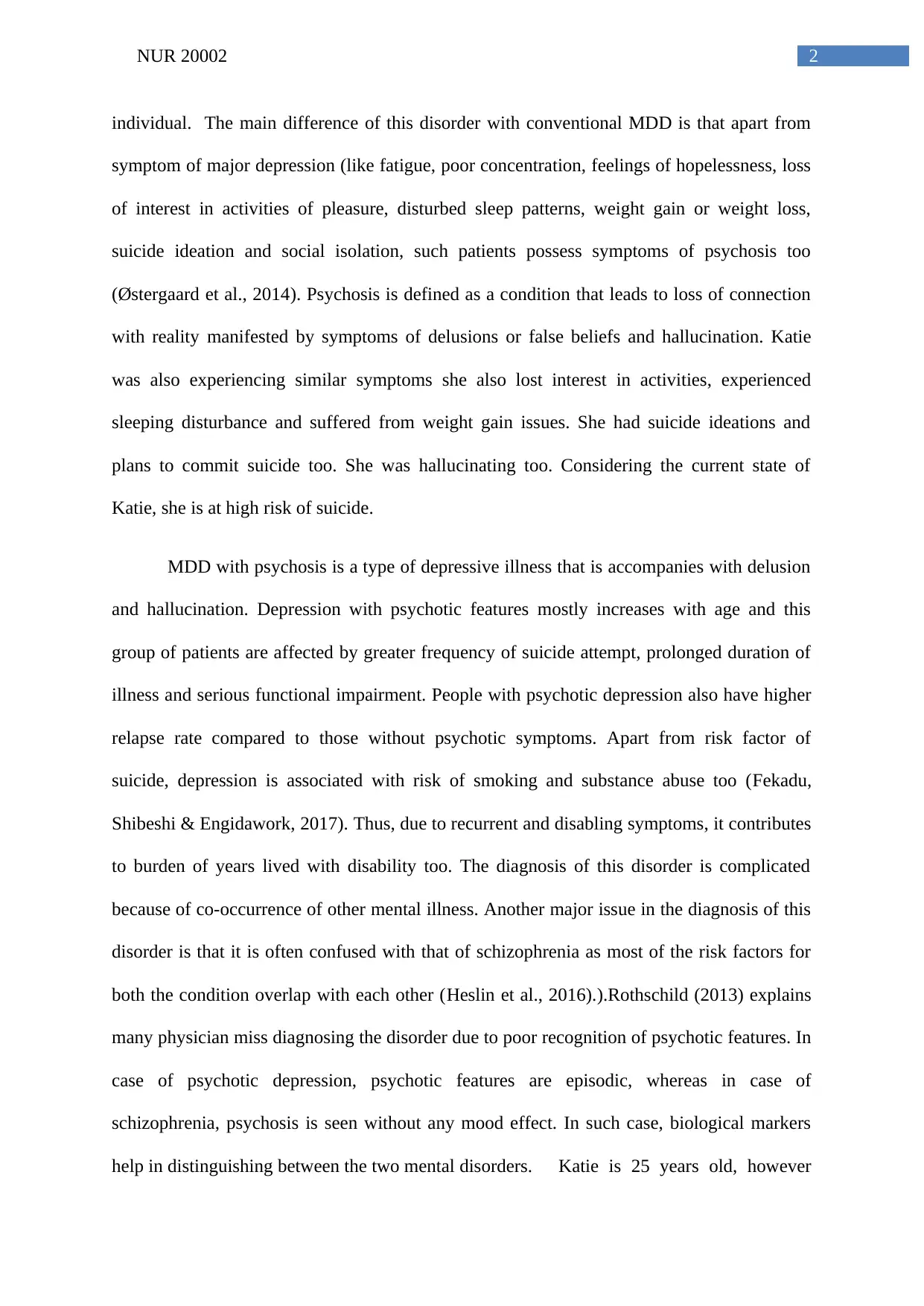
2NUR 20002
individual. The main difference of this disorder with conventional MDD is that apart from
symptom of major depression (like fatigue, poor concentration, feelings of hopelessness, loss
of interest in activities of pleasure, disturbed sleep patterns, weight gain or weight loss,
suicide ideation and social isolation, such patients possess symptoms of psychosis too
(Østergaard et al., 2014). Psychosis is defined as a condition that leads to loss of connection
with reality manifested by symptoms of delusions or false beliefs and hallucination. Katie
was also experiencing similar symptoms she also lost interest in activities, experienced
sleeping disturbance and suffered from weight gain issues. She had suicide ideations and
plans to commit suicide too. She was hallucinating too. Considering the current state of
Katie, she is at high risk of suicide.
MDD with psychosis is a type of depressive illness that is accompanies with delusion
and hallucination. Depression with psychotic features mostly increases with age and this
group of patients are affected by greater frequency of suicide attempt, prolonged duration of
illness and serious functional impairment. People with psychotic depression also have higher
relapse rate compared to those without psychotic symptoms. Apart from risk factor of
suicide, depression is associated with risk of smoking and substance abuse too (Fekadu,
Shibeshi & Engidawork, 2017). Thus, due to recurrent and disabling symptoms, it contributes
to burden of years lived with disability too. The diagnosis of this disorder is complicated
because of co-occurrence of other mental illness. Another major issue in the diagnosis of this
disorder is that it is often confused with that of schizophrenia as most of the risk factors for
both the condition overlap with each other (Heslin et al., 2016).).Rothschild (2013) explains
many physician miss diagnosing the disorder due to poor recognition of psychotic features. In
case of psychotic depression, psychotic features are episodic, whereas in case of
schizophrenia, psychosis is seen without any mood effect. In such case, biological markers
help in distinguishing between the two mental disorders. Katie is 25 years old, however
individual. The main difference of this disorder with conventional MDD is that apart from
symptom of major depression (like fatigue, poor concentration, feelings of hopelessness, loss
of interest in activities of pleasure, disturbed sleep patterns, weight gain or weight loss,
suicide ideation and social isolation, such patients possess symptoms of psychosis too
(Østergaard et al., 2014). Psychosis is defined as a condition that leads to loss of connection
with reality manifested by symptoms of delusions or false beliefs and hallucination. Katie
was also experiencing similar symptoms she also lost interest in activities, experienced
sleeping disturbance and suffered from weight gain issues. She had suicide ideations and
plans to commit suicide too. She was hallucinating too. Considering the current state of
Katie, she is at high risk of suicide.
MDD with psychosis is a type of depressive illness that is accompanies with delusion
and hallucination. Depression with psychotic features mostly increases with age and this
group of patients are affected by greater frequency of suicide attempt, prolonged duration of
illness and serious functional impairment. People with psychotic depression also have higher
relapse rate compared to those without psychotic symptoms. Apart from risk factor of
suicide, depression is associated with risk of smoking and substance abuse too (Fekadu,
Shibeshi & Engidawork, 2017). Thus, due to recurrent and disabling symptoms, it contributes
to burden of years lived with disability too. The diagnosis of this disorder is complicated
because of co-occurrence of other mental illness. Another major issue in the diagnosis of this
disorder is that it is often confused with that of schizophrenia as most of the risk factors for
both the condition overlap with each other (Heslin et al., 2016).).Rothschild (2013) explains
many physician miss diagnosing the disorder due to poor recognition of psychotic features. In
case of psychotic depression, psychotic features are episodic, whereas in case of
schizophrenia, psychosis is seen without any mood effect. In such case, biological markers
help in distinguishing between the two mental disorders. Katie is 25 years old, however
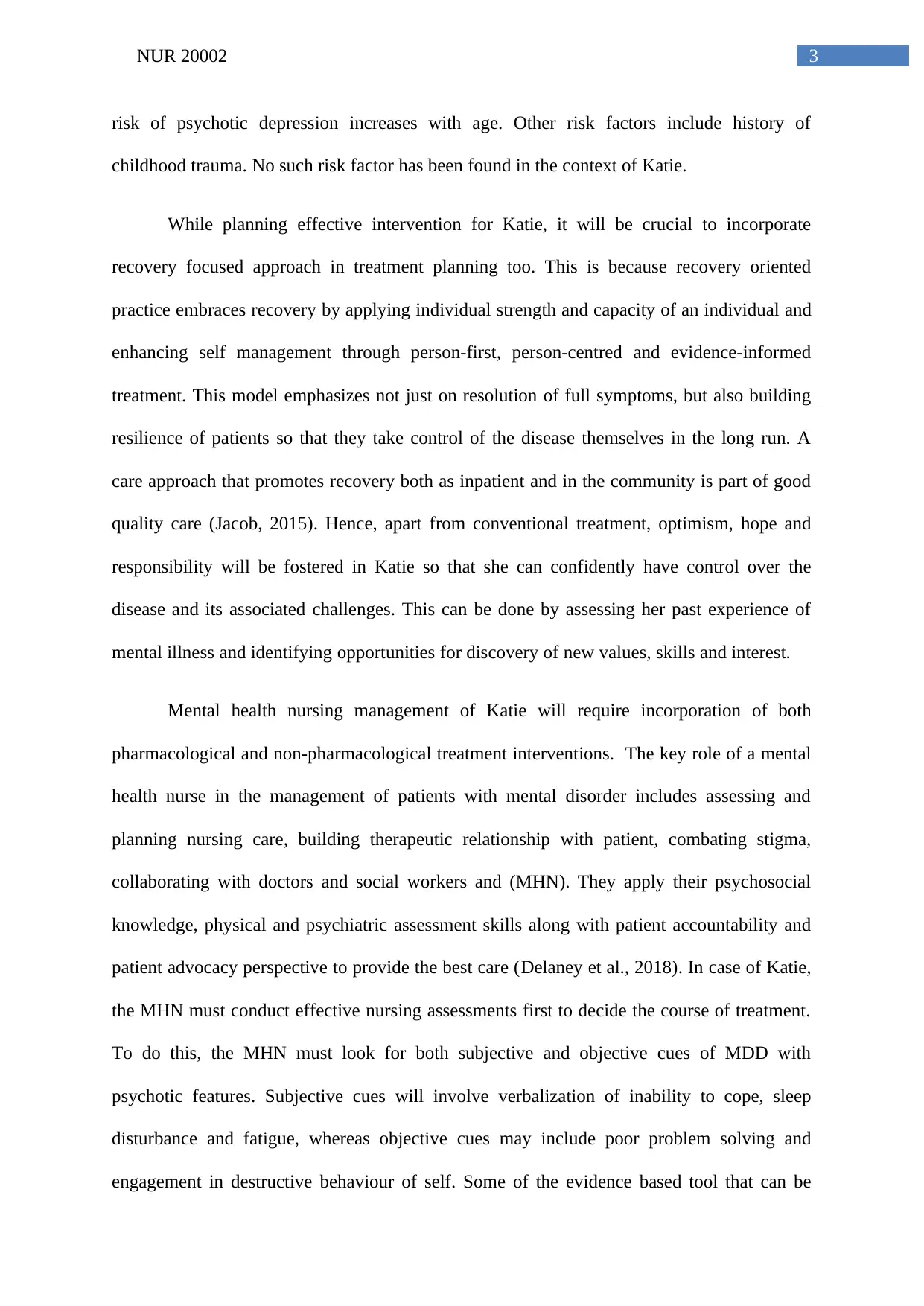
3NUR 20002
risk of psychotic depression increases with age. Other risk factors include history of
childhood trauma. No such risk factor has been found in the context of Katie.
While planning effective intervention for Katie, it will be crucial to incorporate
recovery focused approach in treatment planning too. This is because recovery oriented
practice embraces recovery by applying individual strength and capacity of an individual and
enhancing self management through person-first, person-centred and evidence-informed
treatment. This model emphasizes not just on resolution of full symptoms, but also building
resilience of patients so that they take control of the disease themselves in the long run. A
care approach that promotes recovery both as inpatient and in the community is part of good
quality care (Jacob, 2015). Hence, apart from conventional treatment, optimism, hope and
responsibility will be fostered in Katie so that she can confidently have control over the
disease and its associated challenges. This can be done by assessing her past experience of
mental illness and identifying opportunities for discovery of new values, skills and interest.
Mental health nursing management of Katie will require incorporation of both
pharmacological and non-pharmacological treatment interventions. The key role of a mental
health nurse in the management of patients with mental disorder includes assessing and
planning nursing care, building therapeutic relationship with patient, combating stigma,
collaborating with doctors and social workers and (MHN). They apply their psychosocial
knowledge, physical and psychiatric assessment skills along with patient accountability and
patient advocacy perspective to provide the best care (Delaney et al., 2018). In case of Katie,
the MHN must conduct effective nursing assessments first to decide the course of treatment.
To do this, the MHN must look for both subjective and objective cues of MDD with
psychotic features. Subjective cues will involve verbalization of inability to cope, sleep
disturbance and fatigue, whereas objective cues may include poor problem solving and
engagement in destructive behaviour of self. Some of the evidence based tool that can be
risk of psychotic depression increases with age. Other risk factors include history of
childhood trauma. No such risk factor has been found in the context of Katie.
While planning effective intervention for Katie, it will be crucial to incorporate
recovery focused approach in treatment planning too. This is because recovery oriented
practice embraces recovery by applying individual strength and capacity of an individual and
enhancing self management through person-first, person-centred and evidence-informed
treatment. This model emphasizes not just on resolution of full symptoms, but also building
resilience of patients so that they take control of the disease themselves in the long run. A
care approach that promotes recovery both as inpatient and in the community is part of good
quality care (Jacob, 2015). Hence, apart from conventional treatment, optimism, hope and
responsibility will be fostered in Katie so that she can confidently have control over the
disease and its associated challenges. This can be done by assessing her past experience of
mental illness and identifying opportunities for discovery of new values, skills and interest.
Mental health nursing management of Katie will require incorporation of both
pharmacological and non-pharmacological treatment interventions. The key role of a mental
health nurse in the management of patients with mental disorder includes assessing and
planning nursing care, building therapeutic relationship with patient, combating stigma,
collaborating with doctors and social workers and (MHN). They apply their psychosocial
knowledge, physical and psychiatric assessment skills along with patient accountability and
patient advocacy perspective to provide the best care (Delaney et al., 2018). In case of Katie,
the MHN must conduct effective nursing assessments first to decide the course of treatment.
To do this, the MHN must look for both subjective and objective cues of MDD with
psychotic features. Subjective cues will involve verbalization of inability to cope, sleep
disturbance and fatigue, whereas objective cues may include poor problem solving and
engagement in destructive behaviour of self. Some of the evidence based tool that can be
Secure Best Marks with AI Grader
Need help grading? Try our AI Grader for instant feedback on your assignments.

4NUR 20002
used by an MHS to decide the severity of the disorder for Katie includes the use of the
Hamilton Depression Rating Scale and the 11-item Psychotic Depression Assessment Scale
(PDAS) (Østergaard et al., 2014). Recent research by Park et al. (2017) has validated both the
tools to be effective in assessment of severity. Thus, these tools can be of great utility in
deciding the severity and level of treatment needed by Katie. Providing evidence informed
treatment is part of recovery oriented mental health practice too (Commonwealth of
Australia, 2013).
According to evidence based guidelines, psychotic depression should be treated either
using electroconvulsive therapy (ECT) or using combination of antidepressant and
antipsychotic medication. These are the first line treatment according to various intervention
guidelines like American Psychiatric Association and the Canadian Network for Mood and
Anxiety Treatment. Guidelines for New Zealand and South Africa suggest combination of
antidepressant and antipsychotic medication as first line treatment and ECT as second line
treatment (Rothschild, 2013). As there is recovery oriented focus in treating Katie, she is in
need of both pharmacological and non-pharmacological interventions. Pharmacological
intervention would be effective as psychotic depression (PD) has greater severity compared
to normal depression (Wijkstra et al., 2013). In the contrary, non-pharmacological
interventions would be implemented with the aim of developing resilience of Katie and
changing her feelings of worthlessness to inherent capacity for meaningful life
(Commonwealth of Australia, 2013).
As per clinical evidence, pharmacological intervention for patient with PD may
include either antipsychotic medication or antidepressant or a combination of both. The main
significance of antidepressant treatment is that they enhance the activity of serotonin and
dopamine by inhibition of neurotransmitters in the pre-synaptic neuron. However, the
noradrenergic effect does not lead to therapeutic effect, decrease in symptom of anxiety or
used by an MHS to decide the severity of the disorder for Katie includes the use of the
Hamilton Depression Rating Scale and the 11-item Psychotic Depression Assessment Scale
(PDAS) (Østergaard et al., 2014). Recent research by Park et al. (2017) has validated both the
tools to be effective in assessment of severity. Thus, these tools can be of great utility in
deciding the severity and level of treatment needed by Katie. Providing evidence informed
treatment is part of recovery oriented mental health practice too (Commonwealth of
Australia, 2013).
According to evidence based guidelines, psychotic depression should be treated either
using electroconvulsive therapy (ECT) or using combination of antidepressant and
antipsychotic medication. These are the first line treatment according to various intervention
guidelines like American Psychiatric Association and the Canadian Network for Mood and
Anxiety Treatment. Guidelines for New Zealand and South Africa suggest combination of
antidepressant and antipsychotic medication as first line treatment and ECT as second line
treatment (Rothschild, 2013). As there is recovery oriented focus in treating Katie, she is in
need of both pharmacological and non-pharmacological interventions. Pharmacological
intervention would be effective as psychotic depression (PD) has greater severity compared
to normal depression (Wijkstra et al., 2013). In the contrary, non-pharmacological
interventions would be implemented with the aim of developing resilience of Katie and
changing her feelings of worthlessness to inherent capacity for meaningful life
(Commonwealth of Australia, 2013).
As per clinical evidence, pharmacological intervention for patient with PD may
include either antipsychotic medication or antidepressant or a combination of both. The main
significance of antidepressant treatment is that they enhance the activity of serotonin and
dopamine by inhibition of neurotransmitters in the pre-synaptic neuron. However, the
noradrenergic effect does not lead to therapeutic effect, decrease in symptom of anxiety or
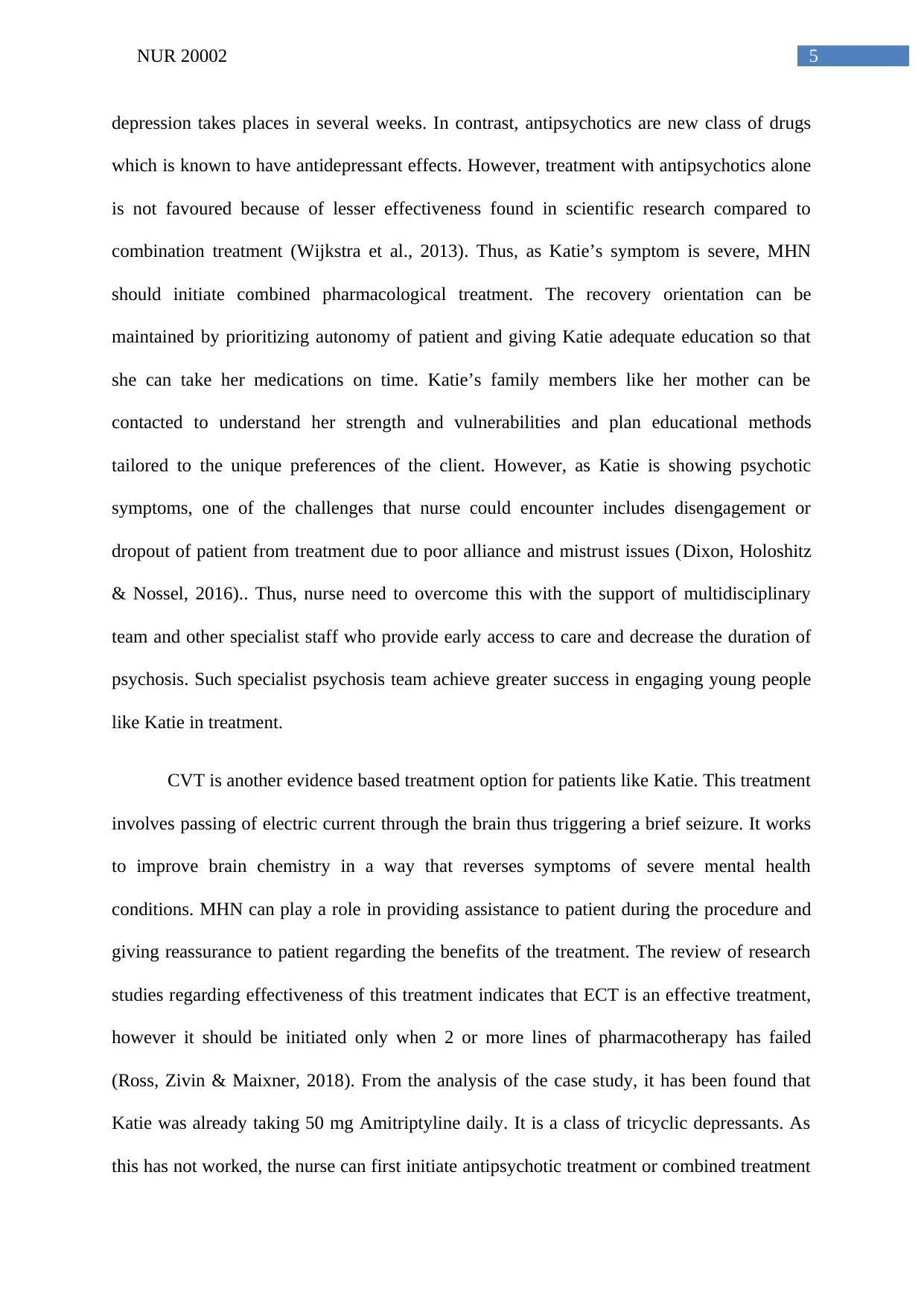
5NUR 20002
depression takes places in several weeks. In contrast, antipsychotics are new class of drugs
which is known to have antidepressant effects. However, treatment with antipsychotics alone
is not favoured because of lesser effectiveness found in scientific research compared to
combination treatment (Wijkstra et al., 2013). Thus, as Katie’s symptom is severe, MHN
should initiate combined pharmacological treatment. The recovery orientation can be
maintained by prioritizing autonomy of patient and giving Katie adequate education so that
she can take her medications on time. Katie’s family members like her mother can be
contacted to understand her strength and vulnerabilities and plan educational methods
tailored to the unique preferences of the client. However, as Katie is showing psychotic
symptoms, one of the challenges that nurse could encounter includes disengagement or
dropout of patient from treatment due to poor alliance and mistrust issues (Dixon, Holoshitz
& Nossel, 2016).. Thus, nurse need to overcome this with the support of multidisciplinary
team and other specialist staff who provide early access to care and decrease the duration of
psychosis. Such specialist psychosis team achieve greater success in engaging young people
like Katie in treatment.
CVT is another evidence based treatment option for patients like Katie. This treatment
involves passing of electric current through the brain thus triggering a brief seizure. It works
to improve brain chemistry in a way that reverses symptoms of severe mental health
conditions. MHN can play a role in providing assistance to patient during the procedure and
giving reassurance to patient regarding the benefits of the treatment. The review of research
studies regarding effectiveness of this treatment indicates that ECT is an effective treatment,
however it should be initiated only when 2 or more lines of pharmacotherapy has failed
(Ross, Zivin & Maixner, 2018). From the analysis of the case study, it has been found that
Katie was already taking 50 mg Amitriptyline daily. It is a class of tricyclic depressants. As
this has not worked, the nurse can first initiate antipsychotic treatment or combined treatment
depression takes places in several weeks. In contrast, antipsychotics are new class of drugs
which is known to have antidepressant effects. However, treatment with antipsychotics alone
is not favoured because of lesser effectiveness found in scientific research compared to
combination treatment (Wijkstra et al., 2013). Thus, as Katie’s symptom is severe, MHN
should initiate combined pharmacological treatment. The recovery orientation can be
maintained by prioritizing autonomy of patient and giving Katie adequate education so that
she can take her medications on time. Katie’s family members like her mother can be
contacted to understand her strength and vulnerabilities and plan educational methods
tailored to the unique preferences of the client. However, as Katie is showing psychotic
symptoms, one of the challenges that nurse could encounter includes disengagement or
dropout of patient from treatment due to poor alliance and mistrust issues (Dixon, Holoshitz
& Nossel, 2016).. Thus, nurse need to overcome this with the support of multidisciplinary
team and other specialist staff who provide early access to care and decrease the duration of
psychosis. Such specialist psychosis team achieve greater success in engaging young people
like Katie in treatment.
CVT is another evidence based treatment option for patients like Katie. This treatment
involves passing of electric current through the brain thus triggering a brief seizure. It works
to improve brain chemistry in a way that reverses symptoms of severe mental health
conditions. MHN can play a role in providing assistance to patient during the procedure and
giving reassurance to patient regarding the benefits of the treatment. The review of research
studies regarding effectiveness of this treatment indicates that ECT is an effective treatment,
however it should be initiated only when 2 or more lines of pharmacotherapy has failed
(Ross, Zivin & Maixner, 2018). From the analysis of the case study, it has been found that
Katie was already taking 50 mg Amitriptyline daily. It is a class of tricyclic depressants. As
this has not worked, the nurse can first initiate antipsychotic treatment or combined treatment
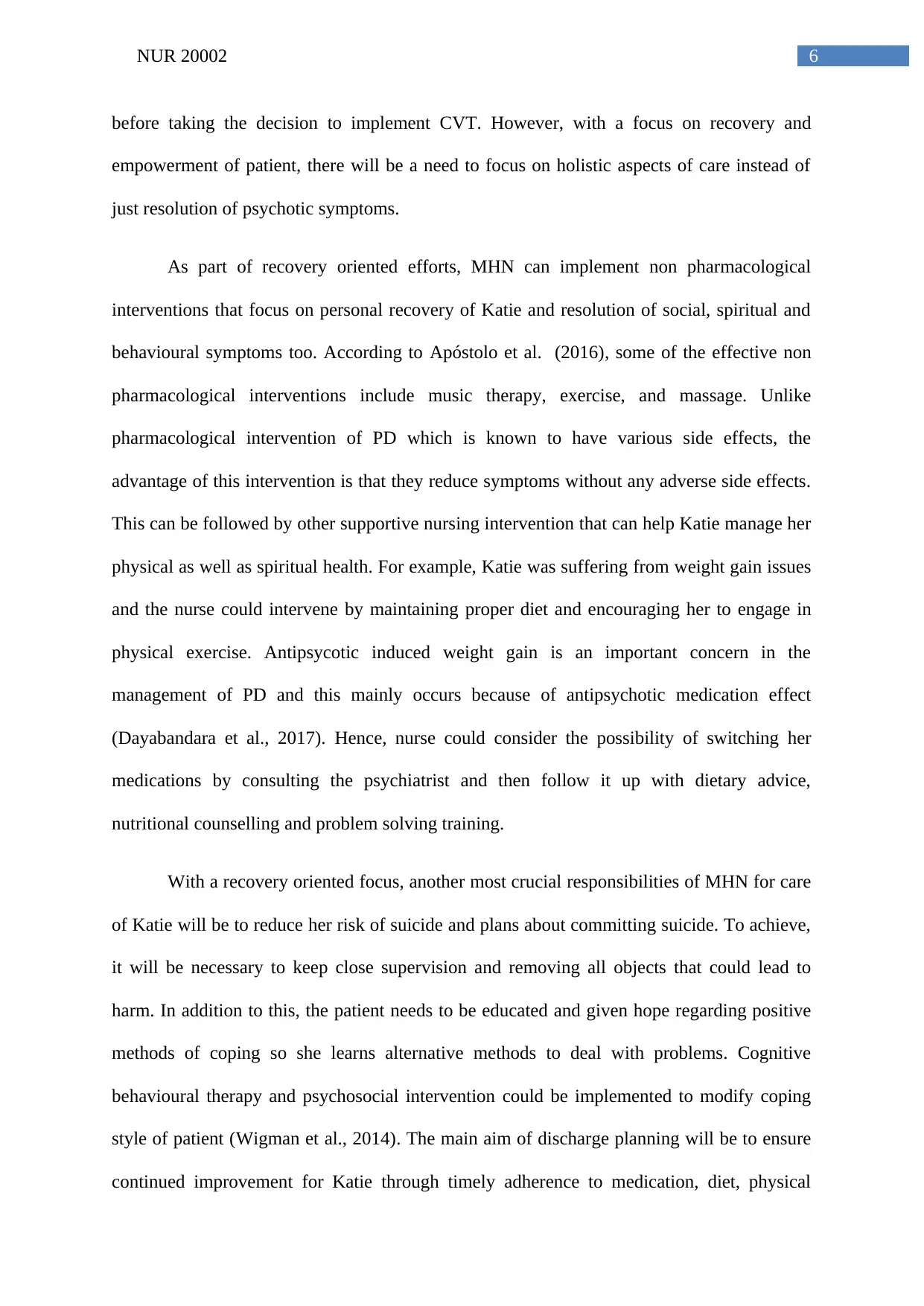
6NUR 20002
before taking the decision to implement CVT. However, with a focus on recovery and
empowerment of patient, there will be a need to focus on holistic aspects of care instead of
just resolution of psychotic symptoms.
As part of recovery oriented efforts, MHN can implement non pharmacological
interventions that focus on personal recovery of Katie and resolution of social, spiritual and
behavioural symptoms too. According to Apóstolo et al. (2016), some of the effective non
pharmacological interventions include music therapy, exercise, and massage. Unlike
pharmacological intervention of PD which is known to have various side effects, the
advantage of this intervention is that they reduce symptoms without any adverse side effects.
This can be followed by other supportive nursing intervention that can help Katie manage her
physical as well as spiritual health. For example, Katie was suffering from weight gain issues
and the nurse could intervene by maintaining proper diet and encouraging her to engage in
physical exercise. Antipsycotic induced weight gain is an important concern in the
management of PD and this mainly occurs because of antipsychotic medication effect
(Dayabandara et al., 2017). Hence, nurse could consider the possibility of switching her
medications by consulting the psychiatrist and then follow it up with dietary advice,
nutritional counselling and problem solving training.
With a recovery oriented focus, another most crucial responsibilities of MHN for care
of Katie will be to reduce her risk of suicide and plans about committing suicide. To achieve,
it will be necessary to keep close supervision and removing all objects that could lead to
harm. In addition to this, the patient needs to be educated and given hope regarding positive
methods of coping so she learns alternative methods to deal with problems. Cognitive
behavioural therapy and psychosocial intervention could be implemented to modify coping
style of patient (Wigman et al., 2014). The main aim of discharge planning will be to ensure
continued improvement for Katie through timely adherence to medication, diet, physical
before taking the decision to implement CVT. However, with a focus on recovery and
empowerment of patient, there will be a need to focus on holistic aspects of care instead of
just resolution of psychotic symptoms.
As part of recovery oriented efforts, MHN can implement non pharmacological
interventions that focus on personal recovery of Katie and resolution of social, spiritual and
behavioural symptoms too. According to Apóstolo et al. (2016), some of the effective non
pharmacological interventions include music therapy, exercise, and massage. Unlike
pharmacological intervention of PD which is known to have various side effects, the
advantage of this intervention is that they reduce symptoms without any adverse side effects.
This can be followed by other supportive nursing intervention that can help Katie manage her
physical as well as spiritual health. For example, Katie was suffering from weight gain issues
and the nurse could intervene by maintaining proper diet and encouraging her to engage in
physical exercise. Antipsycotic induced weight gain is an important concern in the
management of PD and this mainly occurs because of antipsychotic medication effect
(Dayabandara et al., 2017). Hence, nurse could consider the possibility of switching her
medications by consulting the psychiatrist and then follow it up with dietary advice,
nutritional counselling and problem solving training.
With a recovery oriented focus, another most crucial responsibilities of MHN for care
of Katie will be to reduce her risk of suicide and plans about committing suicide. To achieve,
it will be necessary to keep close supervision and removing all objects that could lead to
harm. In addition to this, the patient needs to be educated and given hope regarding positive
methods of coping so she learns alternative methods to deal with problems. Cognitive
behavioural therapy and psychosocial intervention could be implemented to modify coping
style of patient (Wigman et al., 2014). The main aim of discharge planning will be to ensure
continued improvement for Katie through timely adherence to medication, diet, physical
Paraphrase This Document
Need a fresh take? Get an instant paraphrase of this document with our AI Paraphraser
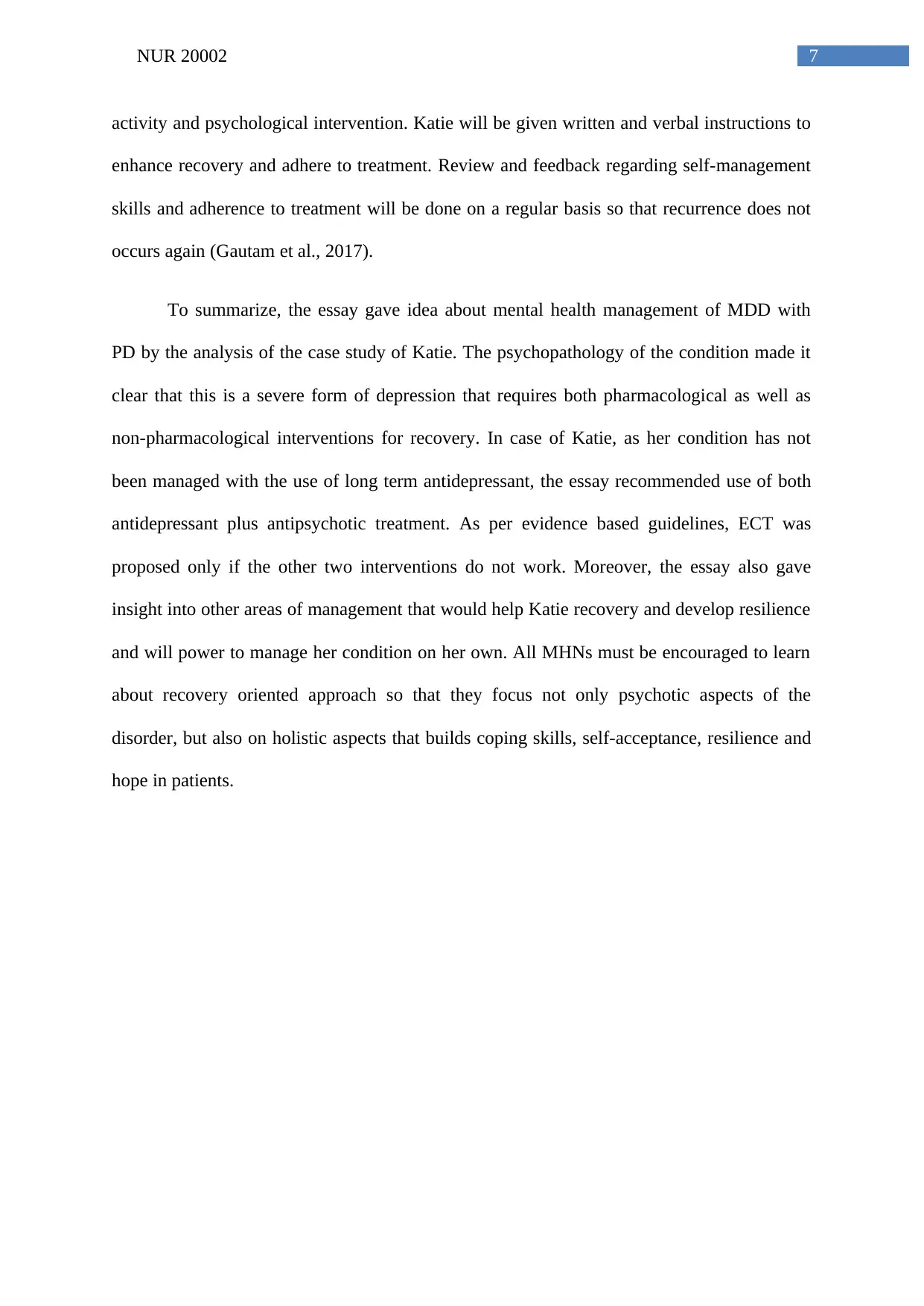
7NUR 20002
activity and psychological intervention. Katie will be given written and verbal instructions to
enhance recovery and adhere to treatment. Review and feedback regarding self-management
skills and adherence to treatment will be done on a regular basis so that recurrence does not
occurs again (Gautam et al., 2017).
To summarize, the essay gave idea about mental health management of MDD with
PD by the analysis of the case study of Katie. The psychopathology of the condition made it
clear that this is a severe form of depression that requires both pharmacological as well as
non-pharmacological interventions for recovery. In case of Katie, as her condition has not
been managed with the use of long term antidepressant, the essay recommended use of both
antidepressant plus antipsychotic treatment. As per evidence based guidelines, ECT was
proposed only if the other two interventions do not work. Moreover, the essay also gave
insight into other areas of management that would help Katie recovery and develop resilience
and will power to manage her condition on her own. All MHNs must be encouraged to learn
about recovery oriented approach so that they focus not only psychotic aspects of the
disorder, but also on holistic aspects that builds coping skills, self-acceptance, resilience and
hope in patients.
activity and psychological intervention. Katie will be given written and verbal instructions to
enhance recovery and adhere to treatment. Review and feedback regarding self-management
skills and adherence to treatment will be done on a regular basis so that recurrence does not
occurs again (Gautam et al., 2017).
To summarize, the essay gave idea about mental health management of MDD with
PD by the analysis of the case study of Katie. The psychopathology of the condition made it
clear that this is a severe form of depression that requires both pharmacological as well as
non-pharmacological interventions for recovery. In case of Katie, as her condition has not
been managed with the use of long term antidepressant, the essay recommended use of both
antidepressant plus antipsychotic treatment. As per evidence based guidelines, ECT was
proposed only if the other two interventions do not work. Moreover, the essay also gave
insight into other areas of management that would help Katie recovery and develop resilience
and will power to manage her condition on her own. All MHNs must be encouraged to learn
about recovery oriented approach so that they focus not only psychotic aspects of the
disorder, but also on holistic aspects that builds coping skills, self-acceptance, resilience and
hope in patients.
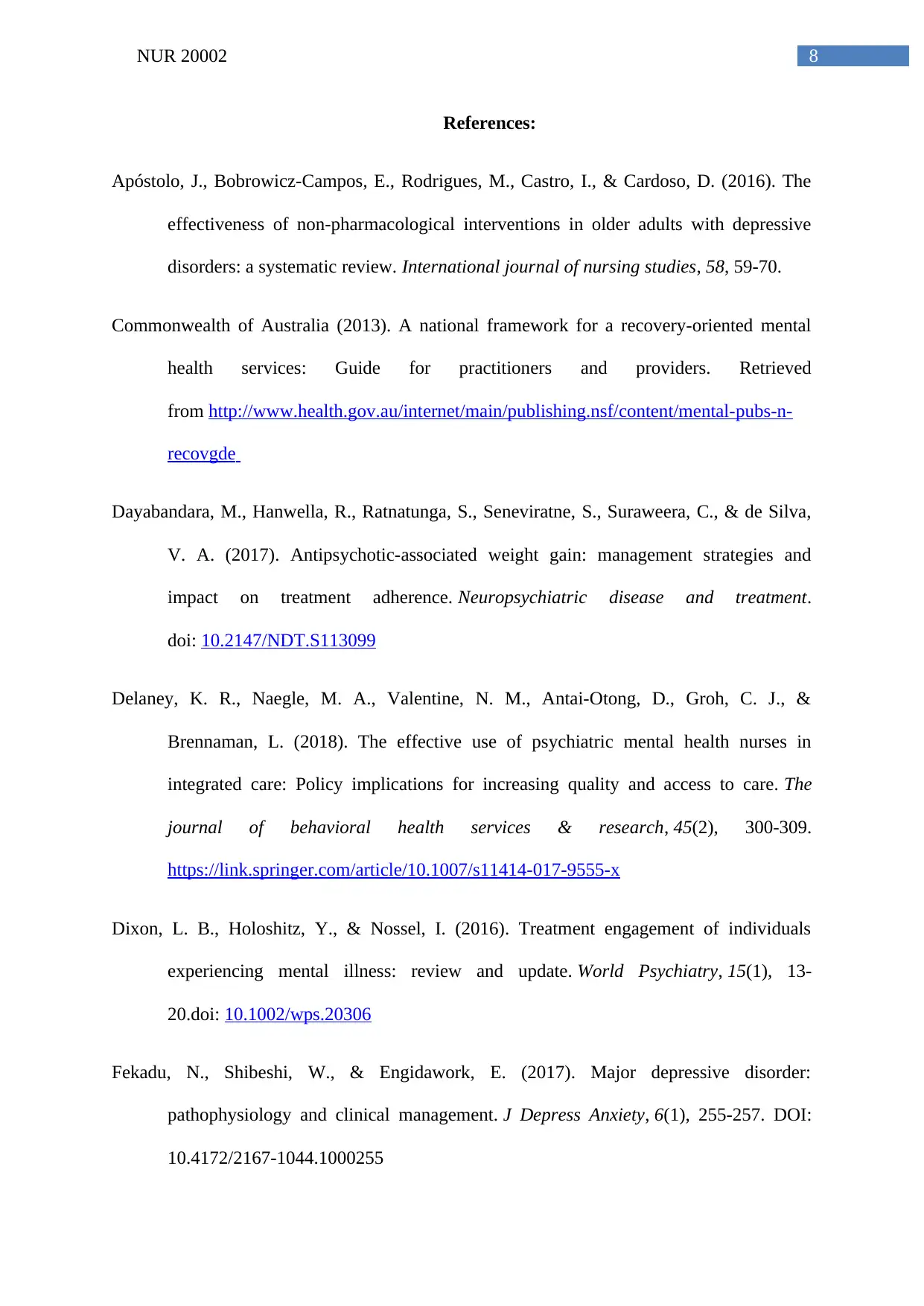
8NUR 20002
References:
Apóstolo, J., Bobrowicz-Campos, E., Rodrigues, M., Castro, I., & Cardoso, D. (2016). The
effectiveness of non-pharmacological interventions in older adults with depressive
disorders: a systematic review. International journal of nursing studies, 58, 59-70.
Commonwealth of Australia (2013). A national framework for a recovery-oriented mental
health services: Guide for practitioners and providers. Retrieved
from http://www.health.gov.au/internet/main/publishing.nsf/content/mental-pubs-n-
recovgde
Dayabandara, M., Hanwella, R., Ratnatunga, S., Seneviratne, S., Suraweera, C., & de Silva,
V. A. (2017). Antipsychotic-associated weight gain: management strategies and
impact on treatment adherence. Neuropsychiatric disease and treatment.
doi: 10.2147/NDT.S113099
Delaney, K. R., Naegle, M. A., Valentine, N. M., Antai-Otong, D., Groh, C. J., &
Brennaman, L. (2018). The effective use of psychiatric mental health nurses in
integrated care: Policy implications for increasing quality and access to care. The
journal of behavioral health services & research, 45(2), 300-309.
https://link.springer.com/article/10.1007/s11414-017-9555-x
Dixon, L. B., Holoshitz, Y., & Nossel, I. (2016). Treatment engagement of individuals
experiencing mental illness: review and update. World Psychiatry, 15(1), 13-
20.doi: 10.1002/wps.20306
Fekadu, N., Shibeshi, W., & Engidawork, E. (2017). Major depressive disorder:
pathophysiology and clinical management. J Depress Anxiety, 6(1), 255-257. DOI:
10.4172/2167-1044.1000255
References:
Apóstolo, J., Bobrowicz-Campos, E., Rodrigues, M., Castro, I., & Cardoso, D. (2016). The
effectiveness of non-pharmacological interventions in older adults with depressive
disorders: a systematic review. International journal of nursing studies, 58, 59-70.
Commonwealth of Australia (2013). A national framework for a recovery-oriented mental
health services: Guide for practitioners and providers. Retrieved
from http://www.health.gov.au/internet/main/publishing.nsf/content/mental-pubs-n-
recovgde
Dayabandara, M., Hanwella, R., Ratnatunga, S., Seneviratne, S., Suraweera, C., & de Silva,
V. A. (2017). Antipsychotic-associated weight gain: management strategies and
impact on treatment adherence. Neuropsychiatric disease and treatment.
doi: 10.2147/NDT.S113099
Delaney, K. R., Naegle, M. A., Valentine, N. M., Antai-Otong, D., Groh, C. J., &
Brennaman, L. (2018). The effective use of psychiatric mental health nurses in
integrated care: Policy implications for increasing quality and access to care. The
journal of behavioral health services & research, 45(2), 300-309.
https://link.springer.com/article/10.1007/s11414-017-9555-x
Dixon, L. B., Holoshitz, Y., & Nossel, I. (2016). Treatment engagement of individuals
experiencing mental illness: review and update. World Psychiatry, 15(1), 13-
20.doi: 10.1002/wps.20306
Fekadu, N., Shibeshi, W., & Engidawork, E. (2017). Major depressive disorder:
pathophysiology and clinical management. J Depress Anxiety, 6(1), 255-257. DOI:
10.4172/2167-1044.1000255
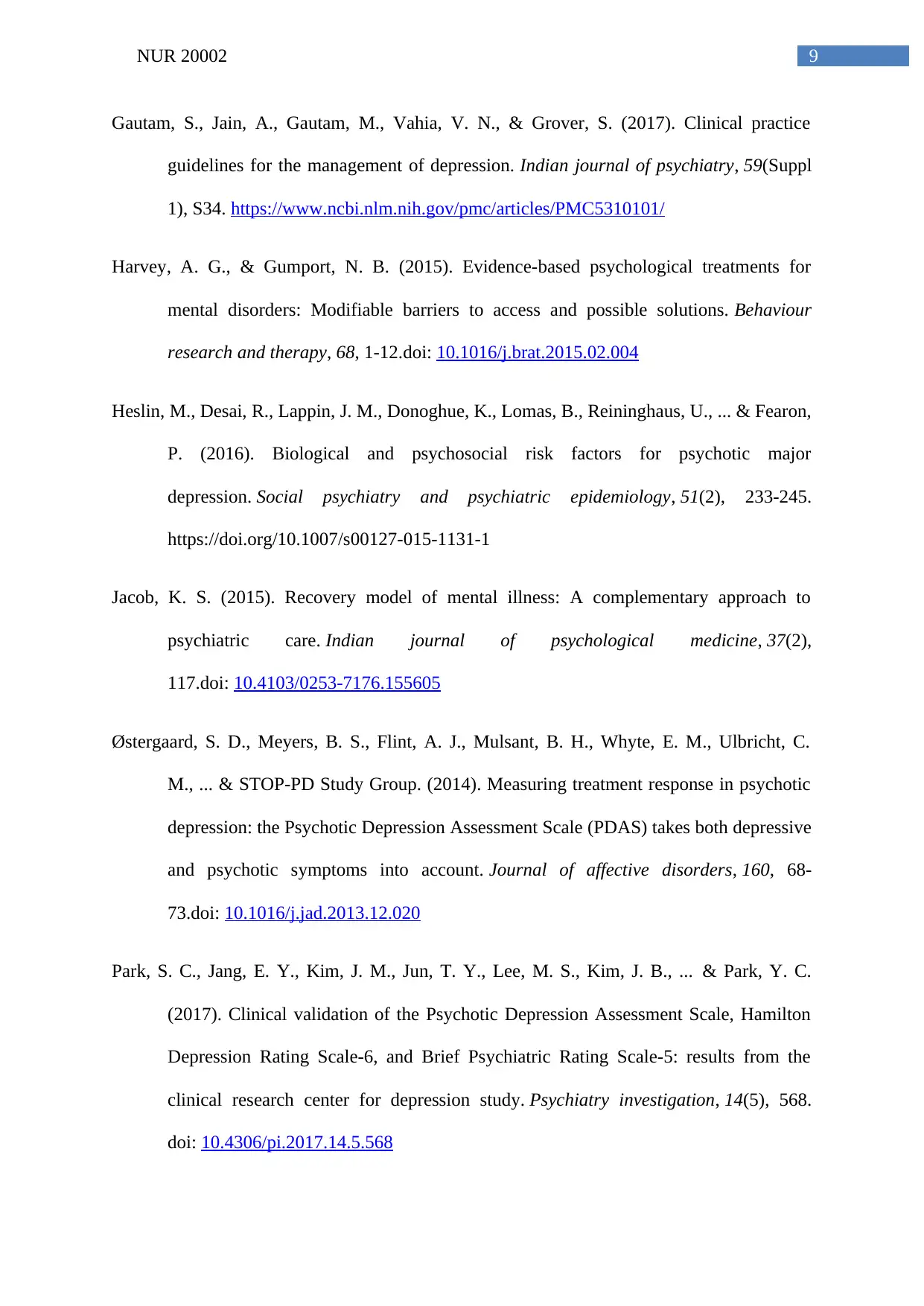
9NUR 20002
Gautam, S., Jain, A., Gautam, M., Vahia, V. N., & Grover, S. (2017). Clinical practice
guidelines for the management of depression. Indian journal of psychiatry, 59(Suppl
1), S34. https://www.ncbi.nlm.nih.gov/pmc/articles/PMC5310101/
Harvey, A. G., & Gumport, N. B. (2015). Evidence-based psychological treatments for
mental disorders: Modifiable barriers to access and possible solutions. Behaviour
research and therapy, 68, 1-12.doi: 10.1016/j.brat.2015.02.004
Heslin, M., Desai, R., Lappin, J. M., Donoghue, K., Lomas, B., Reininghaus, U., ... & Fearon,
P. (2016). Biological and psychosocial risk factors for psychotic major
depression. Social psychiatry and psychiatric epidemiology, 51(2), 233-245.
https://doi.org/10.1007/s00127-015-1131-1
Jacob, K. S. (2015). Recovery model of mental illness: A complementary approach to
psychiatric care. Indian journal of psychological medicine, 37(2),
117.doi: 10.4103/0253-7176.155605
Østergaard, S. D., Meyers, B. S., Flint, A. J., Mulsant, B. H., Whyte, E. M., Ulbricht, C.
M., ... & STOP-PD Study Group. (2014). Measuring treatment response in psychotic
depression: the Psychotic Depression Assessment Scale (PDAS) takes both depressive
and psychotic symptoms into account. Journal of affective disorders, 160, 68-
73.doi: 10.1016/j.jad.2013.12.020
Park, S. C., Jang, E. Y., Kim, J. M., Jun, T. Y., Lee, M. S., Kim, J. B., ... & Park, Y. C.
(2017). Clinical validation of the Psychotic Depression Assessment Scale, Hamilton
Depression Rating Scale-6, and Brief Psychiatric Rating Scale-5: results from the
clinical research center for depression study. Psychiatry investigation, 14(5), 568.
doi: 10.4306/pi.2017.14.5.568
Gautam, S., Jain, A., Gautam, M., Vahia, V. N., & Grover, S. (2017). Clinical practice
guidelines for the management of depression. Indian journal of psychiatry, 59(Suppl
1), S34. https://www.ncbi.nlm.nih.gov/pmc/articles/PMC5310101/
Harvey, A. G., & Gumport, N. B. (2015). Evidence-based psychological treatments for
mental disorders: Modifiable barriers to access and possible solutions. Behaviour
research and therapy, 68, 1-12.doi: 10.1016/j.brat.2015.02.004
Heslin, M., Desai, R., Lappin, J. M., Donoghue, K., Lomas, B., Reininghaus, U., ... & Fearon,
P. (2016). Biological and psychosocial risk factors for psychotic major
depression. Social psychiatry and psychiatric epidemiology, 51(2), 233-245.
https://doi.org/10.1007/s00127-015-1131-1
Jacob, K. S. (2015). Recovery model of mental illness: A complementary approach to
psychiatric care. Indian journal of psychological medicine, 37(2),
117.doi: 10.4103/0253-7176.155605
Østergaard, S. D., Meyers, B. S., Flint, A. J., Mulsant, B. H., Whyte, E. M., Ulbricht, C.
M., ... & STOP-PD Study Group. (2014). Measuring treatment response in psychotic
depression: the Psychotic Depression Assessment Scale (PDAS) takes both depressive
and psychotic symptoms into account. Journal of affective disorders, 160, 68-
73.doi: 10.1016/j.jad.2013.12.020
Park, S. C., Jang, E. Y., Kim, J. M., Jun, T. Y., Lee, M. S., Kim, J. B., ... & Park, Y. C.
(2017). Clinical validation of the Psychotic Depression Assessment Scale, Hamilton
Depression Rating Scale-6, and Brief Psychiatric Rating Scale-5: results from the
clinical research center for depression study. Psychiatry investigation, 14(5), 568.
doi: 10.4306/pi.2017.14.5.568
Secure Best Marks with AI Grader
Need help grading? Try our AI Grader for instant feedback on your assignments.
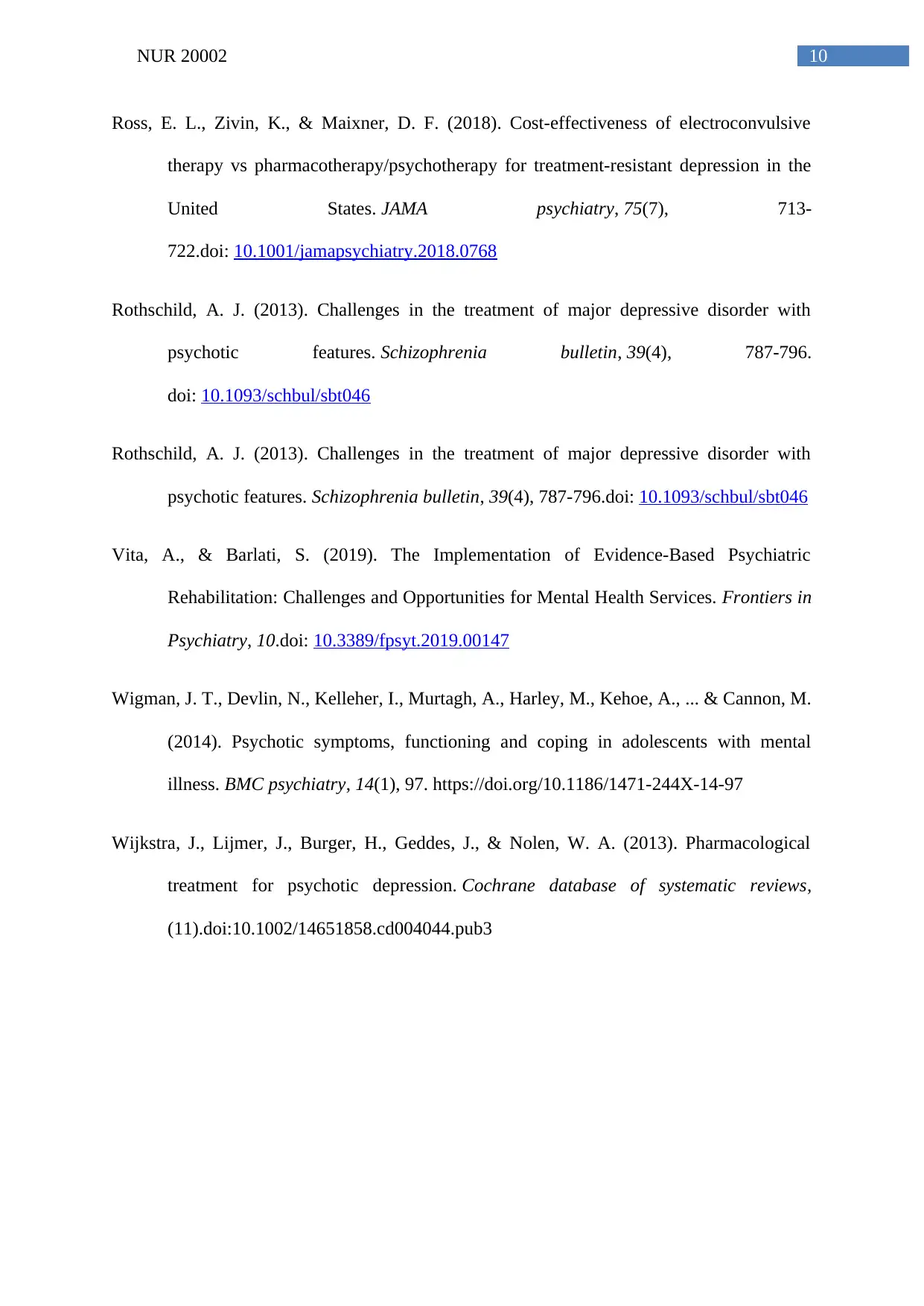
10NUR 20002
Ross, E. L., Zivin, K., & Maixner, D. F. (2018). Cost-effectiveness of electroconvulsive
therapy vs pharmacotherapy/psychotherapy for treatment-resistant depression in the
United States. JAMA psychiatry, 75(7), 713-
722.doi: 10.1001/jamapsychiatry.2018.0768
Rothschild, A. J. (2013). Challenges in the treatment of major depressive disorder with
psychotic features. Schizophrenia bulletin, 39(4), 787-796.
doi: 10.1093/schbul/sbt046
Rothschild, A. J. (2013). Challenges in the treatment of major depressive disorder with
psychotic features. Schizophrenia bulletin, 39(4), 787-796.doi: 10.1093/schbul/sbt046
Vita, A., & Barlati, S. (2019). The Implementation of Evidence-Based Psychiatric
Rehabilitation: Challenges and Opportunities for Mental Health Services. Frontiers in
Psychiatry, 10.doi: 10.3389/fpsyt.2019.00147
Wigman, J. T., Devlin, N., Kelleher, I., Murtagh, A., Harley, M., Kehoe, A., ... & Cannon, M.
(2014). Psychotic symptoms, functioning and coping in adolescents with mental
illness. BMC psychiatry, 14(1), 97. https://doi.org/10.1186/1471-244X-14-97
Wijkstra, J., Lijmer, J., Burger, H., Geddes, J., & Nolen, W. A. (2013). Pharmacological
treatment for psychotic depression. Cochrane database of systematic reviews,
(11).doi:10.1002/14651858.cd004044.pub3
Ross, E. L., Zivin, K., & Maixner, D. F. (2018). Cost-effectiveness of electroconvulsive
therapy vs pharmacotherapy/psychotherapy for treatment-resistant depression in the
United States. JAMA psychiatry, 75(7), 713-
722.doi: 10.1001/jamapsychiatry.2018.0768
Rothschild, A. J. (2013). Challenges in the treatment of major depressive disorder with
psychotic features. Schizophrenia bulletin, 39(4), 787-796.
doi: 10.1093/schbul/sbt046
Rothschild, A. J. (2013). Challenges in the treatment of major depressive disorder with
psychotic features. Schizophrenia bulletin, 39(4), 787-796.doi: 10.1093/schbul/sbt046
Vita, A., & Barlati, S. (2019). The Implementation of Evidence-Based Psychiatric
Rehabilitation: Challenges and Opportunities for Mental Health Services. Frontiers in
Psychiatry, 10.doi: 10.3389/fpsyt.2019.00147
Wigman, J. T., Devlin, N., Kelleher, I., Murtagh, A., Harley, M., Kehoe, A., ... & Cannon, M.
(2014). Psychotic symptoms, functioning and coping in adolescents with mental
illness. BMC psychiatry, 14(1), 97. https://doi.org/10.1186/1471-244X-14-97
Wijkstra, J., Lijmer, J., Burger, H., Geddes, J., & Nolen, W. A. (2013). Pharmacological
treatment for psychotic depression. Cochrane database of systematic reviews,
(11).doi:10.1002/14651858.cd004044.pub3
1 out of 11
Related Documents
Your All-in-One AI-Powered Toolkit for Academic Success.
+13062052269
info@desklib.com
Available 24*7 on WhatsApp / Email
![[object Object]](/_next/static/media/star-bottom.7253800d.svg)
Unlock your academic potential
© 2024 | Zucol Services PVT LTD | All rights reserved.





